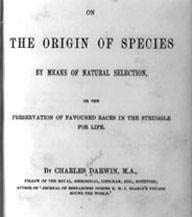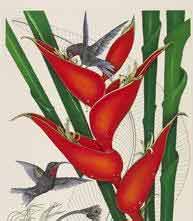VOICE ONE:
This is SCIENCE IN THE NEWS in VOA Special English. I'm Bob Doughty.
VOICE TWO:
And I'm Doug Johnson. November 24th marked the 150th anniversary of one of the most influential books ever written. Naturalist Charles Darwin published "On the Origin of Species" in 1859. The book was an immediate success in the scientific community. Today, evolution forms the basis for the modern science of biology.
(MUSIC)

VOICE ONE:
Evolution can be defined as change in groups of living things over time. Small changes take place in each generation of organisms. Those with useful changes survive to reproduce. Changes that do not aid survival disappear. This is the idea of natural selection. Over long periods of time, these small changes result in the creation of new species. They are the reason for the many different kinds of life on Earth.
The idea that species change was not new even in Darwin's time. The idea dates back to ancient Greece. In the late 18th century, Darwin's grandfather, Erasmus Darwin, suggested that species evolved from their ancestors. He even thought that competition helped drive change.
At the beginning of the 19th century, Jean-Baptiste Lamark attempted a fuller explanation. He suggested that individual organisms changed in reaction to their environment and passed on these traits to the next generation.
VOICE TWO:
Darwin had been working on his theory for over 20 years when he published "On the Origin of Species." Yet it was the work of naturalist Alfred Russel Wallace that pushed Darwin to finally release his theory. Wallace had studied plants and animals in South America and the South Pacific. In 1858, he sent Darwin a short study he had written containing ideas about evolution. Darwin was shocked by its similarity to his own work.
In July of that year, Darwin's friends Charles Lyell and Joseph Hooker had studies by both men presented to the scientific group called the Linnean Society of London. But the first explanation of evolution in public caused little reaction.
A year later, Darwin would complete his detailed study of evolution through natural selection. With its publication, Darwin gained important supporters like Thomas Huxley who were willing to defend his ideas.
(MUSIC)

VOICE ONE:
Evolution, however, did not explain everything about how species evolved. It is important to remember that many of the greatest biological discoveries had yet to be made when Darwin published "On the Origin of Species."
WARREN SCHMAUS: "When Darwin first proposed his theory in 1859, he had no concept of a gene, no concept of a chromosome, no concept of mutation, and certainly no concept of things like DNA and RNA."
Professor Warren Schmaus of the Illinois Institute of Technology says the union of evolution and genetics only started around the 1930s. Also, in Darwin's time, the age of the Earth was estimated only in the millions of years—too short a time some said for evolution to work. Not until the 1950s did scientists, using radioactive dating, place the age of the Earth at over four billion years.
But natural selection has stood the test of time as a basis for the science of biology. Professor Schmaus notes that, before Darwin, naturalists only collected and named species.
WARREN SCHMAUS: "I mean it's hard to even understand how biology was a science as we would recognize it today. I mean, where are the scientific explanations before Darwin?"
VOICE TWO:
To celebrate Darwin and his idea, the Smithsonian Institution's National Museum of Natural History in Washington created a special exhibit. "Since Darwin: The Evolution of Evolution" opened in September. It uses objects from the museum's collection to show how Darwin helped us understand the history of life on Earth. The goal is to show that evolution is not an old, accepted idea, but continues to be the basis for new discoveries, itself changing with modern science.
People from all over the world have visited the exhibit. Many people found the objects and displays helped explain a subject that is hard to understand.
VOICE ONE:
Jim and Irene Mikkelson were visiting Washington from Charlotte, North Carolina when they stopped by the museum. Mr. Mikkelson called the exhibit educational.
JIM MIKKELSON: "I never really realized that that meant that every living thing really came as an evolutionary development of the first seeds of life."
VOICE TWO:
Aravinda Pillalamarri lives in both India and the United States. She brought her daughter Khiyali to the exhibit and was surprised to find how much she already knew.
ARAVINDA PILLALAMARRI: "What I find interesting is how much of evolution she really takes for granted. For her the idea that birds have come from dinosaurs is just common knowledge and there's nothing surprising in that at all."
VOICE ONE:
Keith Leonard attends George Mason University in northern Virginia. He visited the exhibit to research Darwin's big idea.
KEITH LEONARD: "It's based on scientific observation which I think is important. And sort of the same ideas have been confirmed over and over again. I think trying to understand our world is a really complicated endeavor and it's important to have a sort of solid rational approach like science does."
VOICE TWO:
Most visitors spent a long time looking at the display called "The Tree of Life." Darwin explained the evolutionary process as the branching of a tree with complex species developing from simpler ones.
John Kress, a botanist and curator with the Smithsonian, says the team that created the exhibit had a different idea. He says the display was designed to look like a map of the local Washington Metro train system instead of a tree. The reason? All life is connected. Now we know that genetics makes this connection even deeper and we are linked to our ancestors by DNA.
(MUSIC)
VOICE ONE:
Evolution is a theory, a word that is often used to describe an educated guess. But it is a scientific theory based on repeated observations, experiments, measurements and discoveries. A scientific theory represents the best explanation of how the natural world works.
There is almost no disagreement over the main ideas of evolution in the scientific community. But the idea that species have evolved from simpler forms is less accepted by the public. A Gallup Poll opinion study taken last February found that 25 percent of Americans reject evolution. 39 percent accept it and the rest have no opinion.
VOICE TWO:
Many important American court cases have dealt with evolution. The most famous took place in Tennessee in 1925. The trial found high school teacher John Scopes guilty of violating a state law banning the teaching of evolution. Later cases ruled that teaching religious creation stories in public schools violates the First Amendment of the Constitution that calls for separation of church and state.
More recently, religious groups have supported the idea of intelligent design in public schools. This is the idea that an intelligent force created all forms of life. In 2005, a group of high school students brought legal action against a Pennsylvania school district. Dover area schools had required that intelligent design be taught along with evolution. A United States District Court said intelligent design was not science and could not be separated from religious belief.
VOICE ONE:
But there have also been efforts to bridge the differences between religious belief and evolutionary science in recent years. Francis Collins, the director of the National Institutes of Health in Bethesda, Maryland, has attempted to do that. He is a geneticist who led the effort to map all the human genetic material, DNA.
Francis Collins started an organization called the BioLogos Foundation. It is meant to support the idea that traditional Christian beliefs can coexist with science and evolution. In 2006, his book, "The Language of God: A Scientist Presents Evidence for Belief," became a national best-seller.

VOICE TWO:
One hundred fifty years after "On the Origin of Species" first appeared, it remains one of the most influential and debated books ever written. But it is only a beginning. John Kress of the Smithsonian says that, while science accepts evolution, debate continues.
JOHN KRESS: "We do have debates among ourselves over the exact process. And I think this is what science is about. We continually test our ideas; we continually conduct experiments to see if we can gain new insights into how life evolved and that's what really science is all about."
(MUSIC)
VOICE ONE:
This SCIENCE IN THE NEWS was written and produced by Mario Ritter. I'm Bob Doughty.
VOICE TWO:
And I'm Doug Johnson. Visit our Web site at voaspecialenglish.com to find a link to the works of Charles Darwin. And join us again next week for more news about science in Special English on the Voice of America.
chromosome: a threadlike linear strand of DNA and associated proteins in the nucleus of eukaryotic cells that carries the genes and functions in the transmission of hereditary information 染色体
Related stories:
Author pays tribute to Darwin in encyclopedic book, musical stage show
揭秘:达尔文大学生活很奢侈
达尔文故居被提名为世界遗产
Darwin frog(达尔文蛙)
(来源:VOA 编辑:陈丹妮)